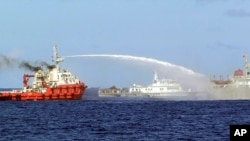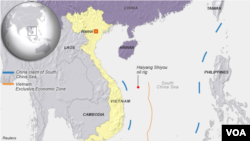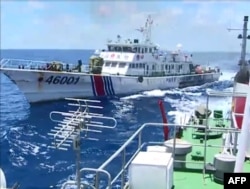WASHINGTON —
The United States says it will withhold judgment for now on the intended destination of four new Chinese oil rigs in the disputed South China Sea. It appears that Beijing is stepping up its exploration for oil and gas two months after positioning a giant drilling platform in waters also claimed by Vietnam.
China announced Friday it will send another four oil rigs to the South China Sea. A Foreign Ministry spokeswoman, Hua Chunying, said they will operate off the coast of China’s Guangdong and Hainan provinces referring to them as ‘normal activities,’ adding there is no need to read too much into them.
Last month, China set off a bilateral dispute with neighbor Vietnam by positioning an oil rig off the Paracel Islands and within Vietnam’s exclusive economic zone (EEZ). That sparked bilateral tensions including anti-China rioting in Vietnam, and confrontations between Chinese and Vietnamese vessels near the rig. High-level talks in Vietnam last week failed to resolve the dispute.
Friday, U.S. State Department spokeswoman Jennifer Psaki said Washington is aware of reports China is towing additional oil rigs to different locations in the South China Sea.
"I think there’s not a great deal of information at this point as to where they’re headed," she said. "If a rig were placed in disputed waters, which would be a concern. And, we certainly have a national interest in the maintenance of peace and stability in the region, so at this point we don’t have enough information about the intended destinations of these rigs, so we’ll hold back judgment until we know more."
The United States criticized the placement of the first oil rig in early May off the Paracels as provocative and destabilizing.
China, which has competing territorial claims in the South China Sea with Vietnam, Taiwan, the Philippines, Malaysia and Brunei, claims most of the waters as its inherent, historical territory.
Carl Thayer, professor emeritus at Australia’s University of New South Wales, who returned from a meeting on South China Sea disputes in Vietnam, says the more rigs China puts in place, the more difficult it will be for Hanoi to monitor them.
"One, two, three, four rigs would stretch Vietnamese paramilitary and fishery surveillance forces to the limit," he said. "Vietnam doesn’t have an awful lot of ships, I think there are 40 total in the coast guard, and they are one-half the size and weight of the Chinese vessels, at least. So, it would be an unequal contest if Vietnam tried adopting the same kind of tactics of protesting."
Thayer says China has already indicated the disputed oil rig off the Paracels is a commercial exploration unit and will only operate between May 2 and August 15, in part due to the onset of the typhoon season.
"But, also by limiting the operations of the oil rig, it has a way to bow out, if you will, gracefully or, as a face-saver, they can just say the commercial activities are over and the rig will be removed," he said.
Thayer says, after August 15, it might be possible for a high-level Vietnamese delegation to go to Beijing in a bid to improve relations. In any event, he says energy industry executives have told him the location of the Chinese rig is not an ideal place to go to first in search of gas.
China announced Friday it will send another four oil rigs to the South China Sea. A Foreign Ministry spokeswoman, Hua Chunying, said they will operate off the coast of China’s Guangdong and Hainan provinces referring to them as ‘normal activities,’ adding there is no need to read too much into them.
Last month, China set off a bilateral dispute with neighbor Vietnam by positioning an oil rig off the Paracel Islands and within Vietnam’s exclusive economic zone (EEZ). That sparked bilateral tensions including anti-China rioting in Vietnam, and confrontations between Chinese and Vietnamese vessels near the rig. High-level talks in Vietnam last week failed to resolve the dispute.
Friday, U.S. State Department spokeswoman Jennifer Psaki said Washington is aware of reports China is towing additional oil rigs to different locations in the South China Sea.
"I think there’s not a great deal of information at this point as to where they’re headed," she said. "If a rig were placed in disputed waters, which would be a concern. And, we certainly have a national interest in the maintenance of peace and stability in the region, so at this point we don’t have enough information about the intended destinations of these rigs, so we’ll hold back judgment until we know more."
The United States criticized the placement of the first oil rig in early May off the Paracels as provocative and destabilizing.
China, which has competing territorial claims in the South China Sea with Vietnam, Taiwan, the Philippines, Malaysia and Brunei, claims most of the waters as its inherent, historical territory.
Carl Thayer, professor emeritus at Australia’s University of New South Wales, who returned from a meeting on South China Sea disputes in Vietnam, says the more rigs China puts in place, the more difficult it will be for Hanoi to monitor them.
"One, two, three, four rigs would stretch Vietnamese paramilitary and fishery surveillance forces to the limit," he said. "Vietnam doesn’t have an awful lot of ships, I think there are 40 total in the coast guard, and they are one-half the size and weight of the Chinese vessels, at least. So, it would be an unequal contest if Vietnam tried adopting the same kind of tactics of protesting."
Thayer says China has already indicated the disputed oil rig off the Paracels is a commercial exploration unit and will only operate between May 2 and August 15, in part due to the onset of the typhoon season.
"But, also by limiting the operations of the oil rig, it has a way to bow out, if you will, gracefully or, as a face-saver, they can just say the commercial activities are over and the rig will be removed," he said.
Thayer says, after August 15, it might be possible for a high-level Vietnamese delegation to go to Beijing in a bid to improve relations. In any event, he says energy industry executives have told him the location of the Chinese rig is not an ideal place to go to first in search of gas.











